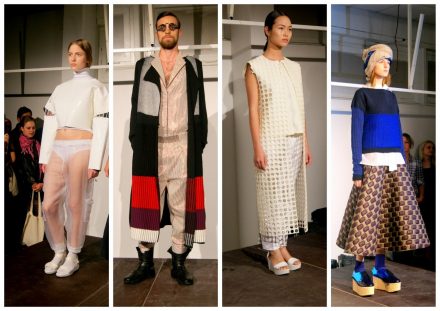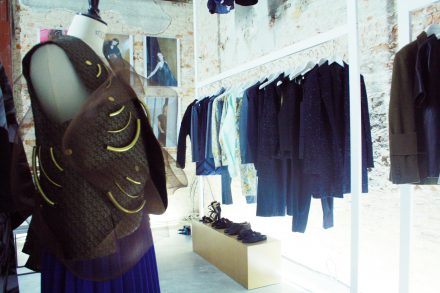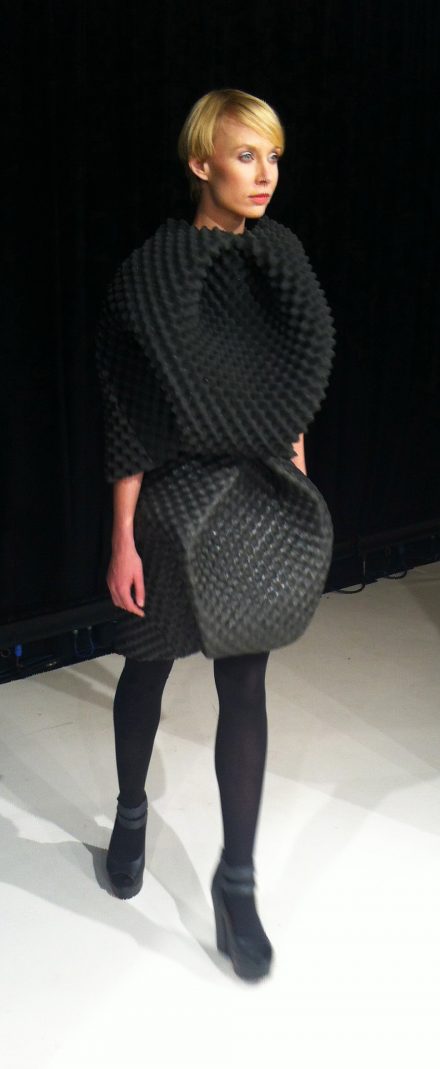
Several weeks ago, ΠMagazine was kindly invited to view the graduation show of FHNW, the Institute for Fashion Design in Basel, Switzerland. After three and a half years of studies, twelve graduates presented their marvelous collection, each uniquely presented in a self-designed presentation setting under the new creative direction of Professor Priska Morger.
Around 1200 international guests are invited once a year to witness the graduate collections at the Kaserne Basel. We at ΠMagazine thrill on the discovery of emerging talents and, needless to say, we were honored to be invited to support these upcoming design talents.
Each designer presented his collection in a multidisciplinary setting of his own design. Between each presentation, the set was changed by ‘the intermezzo’, a group of tough guys in white bomber jackets, providing a connective thread throughout the 12 collections.

Camille Aleña was the first to present her womenswear collection. In contrast to the upbeat sound, the models languished their walks and and punctuated their presentation with exaggerated poses. The presentation culminated in a comic dance performance in which the models, standing on blocks varying in height, synchronized their dance movements. Aleña’s collection was feminine with an ‘I don’t care’ attitude…and check out those shoes!


Bettina Walther transformed the presentation space into a mysterious forest with her self designed lamps positioned on tree trunks. Her menswear collection, ‘I think I saw you in the trees’, was clearly inspired by a foggy forest. The models calmly wandered between the illuminated trunks, draped in oversized pieces in nature inspired colors. Walther used a range of fabrics, varying between light, transparent silks and laces together with heavy, warm wools and woolen braidings.


Joanna Meister presented a colourful womenswear collection, using graphic shapes and strict lines that reminded me of the Jil Sander spring 2011 collection. The craftsmanship and precision in Meister’s work is evident in the final fit and cut.


Elena Donna Görner’s womenswear collection was inspired by the Holi festival in India. Colourful transparent layers referenced the bold coloured powder clouds and fluttering dresses were combined with graphic stockings in bold and nude colors to create the illusion of coloured drenched person.

Jasmine Einsele designed a very wearable menswear collection, presented in an amazing surreal set that centered on an office environment. The collection was presented in whole, with the models simultaneously engaging one another in formal and polite ways. Einsele created a classic menswear collection comprised of dress shirts, jackets and trousers, that was elevated by thoughtful small details such as trouser flaps. Her take on suit wear relies on the dedication to details—visible in the the detailing of pockets, closures and knitting.



Noemie Schelbert presented a womenswear collection consisting of draped dresses and leather pieces. Her collection experimented with the possibilities of leather, employing a special technique to create form fitting netted leather garments and voluminous items fashioned from leather loops.

Nina Brogli was clearly inspired by 90s tracksuits and oversized pimp jackets with tinges of arabic influences. This came very well together in a menswear collection that included felted suits with traces of lace, oversized coats and beanies modeled by sturdy posing gangsters.


Anaïs Marti’s menswear collection employed fur, sturdy leather, form fitting silicon, transparent silks, and loose knittings to create fascinating layers with items of contrasting texture. The furs used were taken from local foxes killed by the government through a mandate aimed at preventing overpopulation.


Nadine Burkhardt designed a setting of mint-coloured podiums to fortify the simplicity of her womenswear collection that hinged on nostalgia. The models walked their trail up the boxes, showcasing elegant dresses with low backs, gloves and shoes with ball-shaped heels reminiscent of bygone decades.


Israel Mariano presented a menswear collection consisting of woven reed garments, gangster fedoras and round wicker sunglasses. The collection was vintage-inspired and wicker is hardly sexy, but I found that the collection created an air of seduction.



Ismaël Ulrich’s menswear collection was more of a statement than a fashion collection. The models wore gold coloured jockstrap, high platform shoes and showed a lot of skin. Between the corsets, exposed flesh, and shiny, uh, cups, the collection provided shock value.

Bettina Mileta definitely put on a show with her menswear collection where she took casual street wear to a whole new level. As if to drive the points of function and wearability home, her models built up a set along with the ‘intermezzo’ boys, whereupon they performed impressive acrobatic moves and flips over the props.


What was quite surprising to me was the high menswear count. Of the twelve graduate collections, five were womenswear collections and seven were menswear collections—something quite uncommon. I appreciated the range of ideas that I encountered with the twelve collections. Each collection was different from other, which speaks to the credibility of the Institute that was able to cultivate a range of interests and directions. I was most impressed by the amount of thought that went into set and performance that simulated professional runways and presentations, where designers often exhaust themselves in search of the perfect elements to contrive a special world to house their collections and ideas.
We would like to thank the graduates for their inspiring work and the university for organizing this special event!






